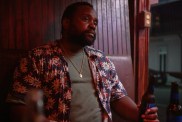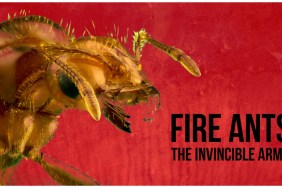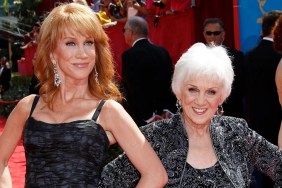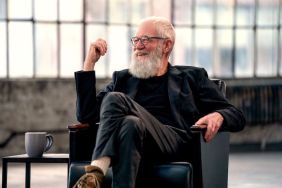On the remake, alternate ending and Atkins!

And so it comes full circle for Patrick Lussier. The man whose editing lent a fearsome rhythm behind the slasher films New Nightmare, the Scream franchise and Halloween: H20 has choreographed, from the director’s chair, his own cinematic slaughter featuring a masked maniac.
After pulling Lionsgate out of a rut helming re-shoots on 2007’s supernatural remake of The Eye, Lussier was granted a “thank you” note in the form of My Bloody Valentine 3D, a Zane Smith and Todd Farmer-scripted redo of George Mihalka’s 1981 Canadian revered film. Lussier welcomed the chance to breath new life into killer Harry Warden, offer him fresh blood to spill with his pick-axe (actors Jensen Ackles, Kerr Smith and Jaime King, to name a few potential “victims”) and do it all in 3D.
MBV3D marks Lussier’s sixth feature. Nine years ago he introduced North American audiences to Gerard Butler in Dracula 2000, a Dimension franchise that would continue through two sequels on DVD without the future King Leonidas but with Lussier still directing. Later, he would do the follow-up White Noise 2 which received theatrical recognition overseas but was kicked to DVD here in the States. And during these years he’d continue editing for Wes Craven.
On the red carpet at MBV3D‘s premiere in Hollywood, Lussier was all smiles – a hint of the amiability he carries that has Todd Farmer calling him the “Ron Howard of horror.” Two days later, at the W hotel in Westwood, I take fifteen minutes to talk with Lussier about Warden’s return, finding the right tone for the remake, its multiple conclusions and casting a beloved genre veteran.
ShockTillYouDrop.com: Well, I’d say the movie was a hit with the audience the other night. They really responded to the 3-D which must be rewarding for you to hear those gasps.
Patrick Lussier: We were really lucky that we went with Paradise Effects, probably the third and smallest of the 3-D companies, because they understood what we wanted to do and [stereographer] Max Penner was very disciplined about how we approached it. He was thrilled we didn’t do things flying in your face every five seconds.
Shock: You do have things flying at your face, but it’s done judiciously.
Lussier: Everything is designed so the whole climax is where we do it. It’s not about, “Here you go…!”
Shock: The Friday the 13th 3-D eyeball gag.
Lussier: Right. When it’s done, it’s done specifically and you build up to it. All the rest is about putting the audience in that world.

Shock: Backtracking a bit, this remake was one that Lionsgate’s been trying to crack for a while. They didn’t know if they wanted something similar or something completely different, correct?
Lussier: Right, the title alone is somewhat intimidating because you’re not sure how to play it. My attitude when I got on board was you lean into the “bloody” of the title and if you don’t, you’re retarded. Very quickly in our conversations with Lionsgate we said that this couldn’t be a PG-13 movie, it has to be R. We have to make it aggressive. If we’re going to resurrect this great killer, then we have to do it in the best way possible. Keep the murder mystery elements of the original film. Keep the love triangle. Keep the mining town. And they completely agreed and were on board with that.
Shock: You were with Wes Craven through the Scream years, and then some, as his editor. Do you feel that time prepared you for this film?
Lussier: Absolutely. We talked about Scream a lot, or I did, when we were in pre-production. The mechanics of Scream, not the self-reference but the mechanics of how it worked. Scream works first and foremost because of the murder mystery. That was the thing Kevin [Williamson] took from all of those old slasher films from the ’80s – from Prom Night, from My Bloody Valentine, from all of those films which have that strong component to it. That was the thing that we kept talking to the studio about: This is how the story has to work and how we have to misdirect and make every character a suspect. Randy’s speech in Scream always played in my head because it’s the perfect encapsulation of what goes into a slasher film. It was a marker of what to do. We got to tell our own slasher film knowing full well what the rules were and how they worked.
Shock: And you approach it with a serious eye, yet you still leave room for a few darkly comedic beats. Nothing wink-wink, though.
Lussier: The goal was to make a movie that was fun. Something that really took you back to that era of those films. Where it was a great Friday night movie and you were going to have a fantastic weekend seeing a movie that was fun to watch and scary. One that didn’t wallow in its dark, morose attitude torturing women and small animals. [laughs]
Shock: The original film was shot on location as was this one which really lends it some authenticity. You could have easily have decided to shoot much of the interior mine scenes on a soundstage…
Lussier: Well, we shot it around Pittsburgh in the little town of Kittanning. The mine is in a place called Tarentum about 40 minutes north of Pittsburgh. It was really fortuitous because the studio realized they could get a great tax break in Pennsylvania. We went to Pittsburgh and within three days of scouting, we found 80% of our locations. It was perfect. We found the mine, outside the mine, the grocery store. This was a perfect place to shoot the movie. So we created this whole photo essay and brought it back to the studio and they were like, “Wow, there it is.”

Shock: Let’s talk about the “bloody” element since you were so keen on staying true to the title. There’s a balance of familiarity and originality to this film’s body count.
Lussier: Gary Tunnicliffe, our special effects make-up guy, came up with this thing called the “document of death.” How many ways can you kill somebody with a pick-axe? In the original film, the miner kills with a variety of tools. Here we wanted to be very specific with his “Excalibur.” There is only one other way he kills somebody in the movie. We wanted to use that pick-axe to its fullest. We heard “Well, you don’t want to hit somebody in the chest every time.” That’s not how it was going to work, so we talked about how it was going to happen. I was sitting in Gary’s shop dancing it out, coming up with these horrific ways. There’s a sequence in someone’s house, I’m going to leave out the name, that came out of the location. That sequence was originally written differently. Then when we were in the location we saw the hallway and where, geographically, we could set [the kill] up. The location re-wrote how that kill was going to work. Working with the actor involved…he brilliantly added the line where he said, “Shit.” It’s a disarming scene then immediately horrific which was so successful.
Shock: Something I picked up on in the film is a scene where Kevin Tighe’s Ben hands Jensen’s character a box that reads “The Dowdle Bros. Funeral Home.” I’m assuming you’re friends with the Dowdles behind Quarantine?
Lussier: [laughs] I first worked with the Dowdles on The Poughkeepsie Tapes. A friend of mine, [executive producer] Michael Zoumas, asked me to come in and watch the film, they were going to shoot some more on that and needed some input on editing. One of my assistants Elliot Greenberg ended up cutting the film and then my son ended up working with them on Quarantine. So I’ve become friends with them.
Shock: Did you ever call on Craven to get some input from him during production?
Lussier: I didn’t, actually. As we were shooting, he was doing 25/8 so I knew he was incredibly busy. I didn’t feel I could impose on him while he was doing that. He saw the movie the other night and got a huge kick out of it.
Shock: Now we’ve got to talk about some serious business here: The casting of Tom Atkins. Did that take some convincing on your part to the powers-that-be?
Lussier: It wasn’t necessarily a fight to get him in. The studio wasn’t totally sure so I had to quickly educate them. Then they were like, “Oh, sure, he’d be fine.” But I was said, “You don’t understand, this will be huge. This will be an amazing thing to have him in.” And we beefed up the role once we got Tom and tailored it much more for him. He lives in Pittsburgh and Tom Piccirilli, the thriller novelist, is a friend of mine and had gone to a horror convention in Pittsburgh and told me he lived there – I didn’t know that. I immediately called the Pittsburgh casting office and they asked me right away if I’d like to meet him. Yes! We met for coffee and it was like we had been friends for a million years. I remember seeing The Fog for the first time and was just like, “Oh my God, it’s Tom Atkins!”

Shock: If Tom Atkins was the lead in this movie, how long would it have taken for his character to sleep with the leading lady?
Lussier: [laughs] I’d say about ten minutes of screen time. Tom is the sweetest man and has acted in so many films. He understands the genre intuitively and what makes it works. He’d do a take and say, “Okay, in this take I’m going to act like I’m the killer. I’ll be more suspicious this time.” He had such a great sense of it all. I hope this allows people to rediscover Tom. He should be in more movies because he’s so good and has such a great face and screen presence.
Shock: Turning to the future, tell me a bit about Headhunter…
Lussier: We have a script and we’re looking for financing. It’s sorting itself out in that regard and is a great adaptation of the Michael Slade book. It’s an incredible murder mystery set against the background of the RCMP [Royal Canadian Mounted Police] and, in the original book, it’s the Vancouver City Police but for our script it’s the RCMP and the FBI. We interviewed one of the RCMP and he was telling us they think in Vancouver there are 300 FBI agents. I would have thought there were five. Because it’s a main border port they actually don’t know how many there are up there. When we started to incorporated that FBI element it became cool and a vital way to sell this story to an American audience. It definitely has a L.A. Confidential cop vibe with a brutal killer and it’s told in multiple time periods. It’s a cop/drama/horror.
Shock: So are you putting the editing to bed for now and focusing on directing?
Lussier: I still enjoy editing but I’d like to lean more towards directing and editing my own stuff and hope to continue doing that.
Shock: On a final note, you’ve shot multiple endings for MBV3D. Can you elaborate on why?
Lussier: We shot a few different ones. The ending you see now in the film came to us while we were shooting. We called the studio and they said, “Just shoot the other endings so we have them.” But then it became very clear what’s in the film now is the only way to end it. You’ll see them on the DVD. We did some hybrid cut of all of the endings into one which we had not thought of when we shot it, but during editing we realized it could work when you put them all together. It’s incredibly effective.
My Bloody Valentine 3D opens in theaters in 2-D and 3-D on January 16th.




Source: Ryan Rotten, Managing Editor









